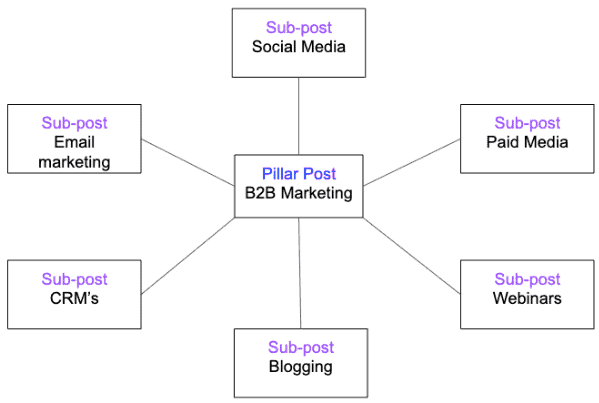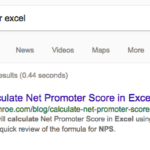In a previous blog post, I talked about different types of content and how to use them.
To expand on that, I would like to share my tried and tested B2B content marketing tips for planning and executing a content marketing strategy that leads to steady success in lead generation.
Make a plan and stick to it
Churning out blogs as often as possible is no longer going to work, thankfully. These days, Google is more sophisticated and likes longer and more useful content that’s well planned.
A good content plan that is also well-executed can take anywhere between 4 to 6 months to show results. So be patient and don’t waver from the consistent production of high-value content in a well thought out inbound marketing strategy.
Publishing one blog a week is the recommended schedule. Being late once in a while or posting with a two-week gap isn’t going to kill the progress but being consistent will likely lead to better results.
To build an effective plan you’ll need a few key components
- Buyer’s persona – based on existing clients and MQL’s.
- Buyer’s journey – a well built buyer’s journey is the foundation of building a concrete marketing funnel.
- Goals e.g. to increase the number of phone calls made to BOTF prospects per week to 2
Keywords: How to find the ones that help you rank in Google
You might already have some keywords in mind consisting of what you’ve heard people say, what you call your service or product or what you’ve heard on popular media. Having these ideas are good, but don’t be married to them.
You need to test what you have and make sure Google recognises them as what you think they are. This is called Keyword Intent.
A simple way to gauge Keyword Intent is to perform a Google search on your keywords and taking a look at the results on the first page. Particularly the top five results. Here’s where you can check if most of the search results are about the same topic you want to talk about.
For example you’re a mobile phone provider for businesses and you think “mobile fleet management” is a good keyword. However, upon searching it in Google, you find that most of the results are for GPS tracking of vehicles. This would mean that the keyword you have selected won’t be good for your pillar post because it’s about the wrong thing.
Check out your Competitors Keywords
Take a look at your competitors websites and social media channels to see what they are calling your products and services. You don’t necessarily have to use the keywords that your competitors are using.
In fact, finding out what larger competitors are using could allow you to avoid highly competitive keywords that are more difficult to rank for on Google.
Finding Keywords that are Relevant
Place your most relevant keywords into answerthepublic, a free web tool which generates possible keyword combinations that have been used in Google searches.
This is a great tool we use for every pillar post we research, it gives you long-tail variations of the simplified keyword you key in.
Answerthepublic gives you three free searches a day. The best way to make use of this limit is to ensure you use short-tail keywords that:
- Accurately reflect your products and services
- Have high-search volumes on Google
- Are the most relevant to your company
You’ll hopefully get a wide variety of associated long-tail keywords, some that are more appropriate for use on your service pages and homepage, and some that are better suited for blogs.
Focus on your most Relevant Keywords
The results from answerthepublic can be voluminous. You’re looking at up to 1,000 if the particular keyword you chose is a popular search term. It’s worth filtering out the irrelevant ones before you move on to the next stage.
After you’ve narrowed down the long-tail search results, they need to be evaluated for search volumes and difficulty in an SEO tool like Moz or SEMRush. Most of these tools have a monthly or even daily limit for how many words you can search, so ensure you’ve narrowed it down to the ones that are really relevant.
It’s wise to pick keywords with at least some search volume in your region and a lower difficulty.
Pillar posts – What are they and how to plan them
Now that you have your keywords you can start building a structure for your pillar posts.
Pillar posts are long blog posts containing content for a larger topic that is hyperlinked to and from smaller, more specific blog posts within the same topic.
Pillar posts can be pretty long, up to 3000 words, and not generally less than 1,000 is usually a good region. They are separated into different sub-topics which link to the smaller blogs. The image below shows the basic structure of a pillar post topic.

Characteristics of High-Value, Google Friendly Blog Posts
Creating high-value blog posts takes practice. Here are the basics:
- Useful – your keywords can help with that along with your own professional knowledge
- Easy to read – Paragraphs should be 1 to 2 sentences long and no more than 4 sentences long. Shorter sentences are better. Generally speaking, Google doesn’t favor sentences that are over 20 words long, so between 5 and 15 is a happy medium
- Thorough – Google usually likes longer blogs, with multiple H2’s (the second largest heading used for sub-headings in a template) that are relevant to the blog keyword, so try to write blogs over 800 words. H2’s should be separated by a few paragraphs, 5 or less.
- Grade your content: After writing a blog you can use the on-page grader in Moz which tells you if the structure of the content and the frequency of keywords throughout the copy will make Google happy and rate the content out of 100. You want to aim for something in the high 90’s.
The Do’s and Don’ts of Downloadables
Downloadables are content that you place behind a form that requires your prospects to provide their contact details to gain access. It’s what you use to gain conversions on your website and your blog. Done right, downloadables can convert a percentage of traffic to a specific page from mere site visitors into MQL’s.
Here are a few tips to effective downloadables.
- Don’t try and make it perfect and super amazing. In most cases, your prospects don’t even look at the downloadables.
- Do make it beneficial and make sure it contains what it says on the tin. If it’s a checklist, just create checklist. It doesn’t require lots of design work.
- Do use your downloadables as CTAs on different blogs, social media platforms, website pages etc. It allows you to check what working and what isn’t. Be aware that you may have different audiences on different platforms.
Place a CTA in every blog post
Absolutely every blog post you publish has to have a CTA because any visitors to a page on your website needs a chance to convert. Without a CTA, you could be losing valuable leads.
Two CTA’s are recommended in blog posts because of the length and the amount of scrolling required when reading. You can make both of them the same CTA, one at the start of the post and one at the very end if the downloadable is relevant throughout the post. If the same CTA isn’t relevant at different points of the blog post then use different CTA’s.
The more relevant the CTA is to the paragraph that precedes it, the more likely readers will click to your landing page. Of course there are many other variables responsible for the click-through rates of CTA’s, but the placement and the relevance to surrounding content are pretty up there and very much within your control.
Maximise conversions with webinars
A great CTA can be a relevant webinar.
Webinars are best used for bottom of the funnel offers. So if you’re writing a blog that’s also BOTF (bottom of the funnel) or MOTF (middle of the funnel) then a relevant webinar would make a great offer.
When running webinars, you get the rare opportunity to share and converse with your prospects. Here’s where you find out how many people are really interested in your subject matter.
You should also keep a close eye on the people who are actually engaging with the webinar content, ie asking questions and responding to polls. These are the people that are most likely to want to learn more and continue the conversation after the webinar.
Have a follow-up plan for all the engaged participants of the webinar. Be it an email and/or a phone call.
It’s usually best to contact attendees within a day or two so that the content of the webinar is still fresh in their minds.





